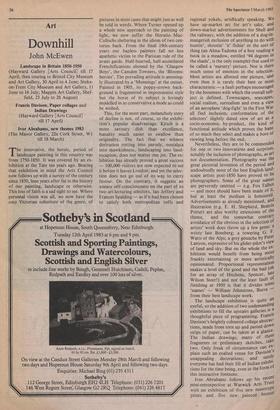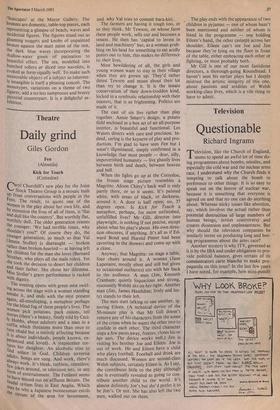Art
Downhill
John McEwen
Landscape in Britain 1850-1950 (Hayward Gallery [Arts Council] till 17 April; then touring to Bristol City Museum and Art Gallery, 30 April to 4 June; Stoke- on-Trent City Museum and Art Gallery, 11 June to 16 July; Mappin Art Gallery, Shef- field, 23 July to 28 August) Ivor Abrahams, new themes 1983 (The Mayor Gallery, 22a Cork Street, W1 till 18 March)
The innovative, the heroic, period of landscape painting in this country was from 1750-1850. It was covered by an ex- hibition at the Tate ten years ago. Bearing that exhibition in mind the Arts Council now follows up with a survey of the century since 1850, lean years after fat in the history of our painting, landscape or otherwise. This loss of faith is a sad sight to see. Where personal vision was all, we now have the cosy Victorian substitute of the genre, of
pictures in most cases that might just as well be told in words. Where Turner opened up a whole new approach to the painting of light, we now suffer the Horatio Mac- Cullochs sheltering in the idiom of two cen- turies back. From the final 19th-century years our hapless painters fall no less apathetic victim to the Parisian rule of the avant garde. Half-hearted, half-assimilated Frenchifications abound by the 'Glasgow Boys', the Camden Towners, the 'Blooms- berries'. The prevailing attitude is amusing- ly illustrated by a 'Munnings' at the outset. Painted in 1905, its poppy-strewn back- ground is fragmented in impressionist style but the horse of its subject is lovingly modelled in as conservative a mode as could be wished.
This, for the most part, melancholy story of decline is not, of course, to the exhibi- tion's popular disadvantage. Kitsch is a more savoury dish than excellence, banality much easier to swallow than originality. The fact that we witness derivation rotting into parody, nostalgia into mawkishness, landscaping into land- escapism, does not matter one jot. The ex- hibition has already proved a great success — 100,000 visitors are now expected to see it before it leaves London; and yet the selec- tion does not go out of its way to curry favour. On the contrary, it suggests an uneasy self-consciousness on the part of its two art-lecturing selectors, Ian Jeffery and Frances Spalding — as if it had been chosen to satisfy both metropolitan toffs and regional yokels, artistically speaking. We have up-market art for art's sake, and down-market advertisements for Shell and
the railways, with the addition of a dog-1nmangerish exclusion of anything to do with huntin', shootin"n' fishin' or the sort of thing (an Alma-Tadema of a boy reading a book in a meadow, entitled '94 degrees in the shade', is the only example) that used to be called a 'nursery' picture. Nor is there much sense of emotion in the selection. Most artists are allotted one picture: and even then it is rarely their best or most characteristic — a fault perhaps encouraged by the looseness with which the overall sub- ject is defined. Townscapes, seascapes, social realism, surrealism and even a view of an aeroplane 'dog-fight' in the First War all find inclusion; conformation of the selectors' slightly dated view of art as a socio-economic by-product, the kind of functional attitude which proves the bane of so much they select and makes a bore of viewing long,before the end. Nevertheless, they are to be commended for one or two innovations and surprises, notably the inclusion of photographs, as art not documentation. Photography was the great pictorial invention of the period and undoubtedly most of the best English land- scape artists post-1850 have proved to he photographers. Some of the great names are perversely omitted — e.g. Fox Talbot — and more should have been made of it, but at least the medium is honoured. Advertisements as already mentioned, and illustration (e.g. E. H. Shepherd, Beatrix Potter) are also worthy extensions of the theme, and the somewhat contrarY avoidance of the obvious in the selection of artists' work does throw up a few gems: a wristy late Bomberg; a towering 0- F. Watts of the Alps; a grey gouache by Peter Lanyon, expressive of his glider-pilot's view of land and sky. But on the whole the ex- hibition would benefit from being in°1e frankly entertaining or more artisticallY opinionated. Proportional representation makes a level of the good and the bad (011 for an array of Hitchens, Spencer, late, Wilson Steer!) and not the least fault 0 finishing at 1950 is that it divides 50me1 'names' — William Johnstone, Burra --- from their best landscape work. The landscape exhibition is quite all eyeful, so the addition of two 'undemanding exhibitions to fill the upstairs galleries is 3 thoughtful piece of programming. Francis Davison's brightly coloured collage abstrac- tions, made from torn up and pasted down strips of paper, can be taken at a glance' The Indian drawings, many of then] fragments or preliminary sketches, take two. Only freak of circumstance can ex- plain such an exalted venue for Davison's unappealing decorations; and surelY everyone has had their fill of Indian exhibi-, tions for the time being, even in the form 01 this instructive footnote. Ivor Abrahams follows up his recent mini-retrospective at Warwick Arts Trust with an exhibition of five new monotyPe prints and five new painted bronze 'Seascapes' at the Mayor Gallery. The bronzes are domestic, table-top pieces, each representing a glimpse of beach, waves and incidental figures. The figures stand out as gleaming nuggets and knobs of unpainted bronze against the matt paint of the rest, the dark blue waves incorporating the shallow-water green of patination to beautiful effect. The sea, modelled into bunched rollers or sliced into wavelets, is evoked as form equally well. To make such memorable objects of a subject so inherent- ly intangible is itself a pleasing conceit. The raonotypes, variations on a theme of two figures, add a no less sumptuous and breezy pictorial counterpart. It is a delightful ex- hibition.















































 Previous page
Previous page